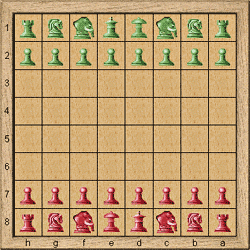|
 |
Origin
Since this game is considered the predecessor of the modern chess, and possibly it is also the predecessor of the Chinese chess (Xiang qi) and Japanese chess (Shogi), many estudies had been made about chaturanga. If you want more information about it, just search in the related links.
It seems that Chaturanga cames from India, and the first references were made in the 4th century BC.
The earliest versions were very different, since four armies used to take part in the game and dice were used to decide the piece that had to be moved.
The game arrived to Europe through Persian and Arab countries, progressing until turn in chess.
Description
The version described here is the same that you can play; it is the more modern, so it is the more similar to the modern chess.
Due to that similarity, the rules of Chaturanga will be explained bringing out the differences with chess.
Chaturanga is played on an uncheckered 8x8 board. However, unlike chess, all the squares have the same colour.
The number of pieces for every player and the starting position is similar to chess. But, as well as colour (pieces are white or green for one of the players, red for the other), these are the differences:
- Instead of bishop, elephants are used
- Instead of the queen, a minister
- The king and the adviser are placed, like chess, in central squares of the first row. The difference is that in Chaturanga, independently of the colour, adviser is placed always on the left of the king
Objective
The objective in Chaturanga is to checkmate the opponent king; but, unlike chess, the stalemated king gets the victory.
How the game goes on
Game takes place like chess: white (or green) starts, players move alternatively reaching the checkmate. These are the special characteristics in Chaturanga:
Moves
- Pawn: moves like chess pawn, but it may not advance two squares in the first move. So, pawn advances one square vertically, and captures by advancing one square diagonally
- Rook: moves like chess, vertically or horizontally
- Horse: same as chess. Moves like an L in any direction, and may jump over own an opponent pieces
- Elephant: moves two squares diagonally, forwards or backwards, and may jump over any piece
- Adviser: moves one square diagonally, forwards or backwards
- King or Rajah: same as chess, it can be moved one square in all directions. He may move also like a horse, but only once during all the game, and he must not be checked to make that move
Capturing
There is no difference with chess when making captures: the moved piece is placed in the square occupied by an opponent piece, and this last piece is taken out of the board.
Promotion
Pawns promote when they reach their last row (the first row for the enemy). Unlike chess, in chaturanga pawn doesn´t become the piece that the owner wants, it just become the kind of piece that occupied the same square at the start of the game. There is also another limit: the piece introduced in the board must be one of the previously captured pieces; so, it is not possible to have three rooks, three horses, three elephants or two advisers at the same time. The pawns that do not promote stay over the board and may not be moved.
Play now
Play online with some other players
Related links
Copyright © 2001-2024 Ludoteka.com Jokosare S.L. All rights reserved - Disclaimer - Contact
